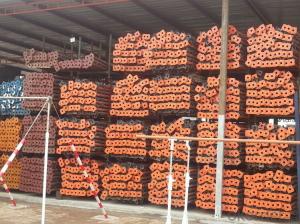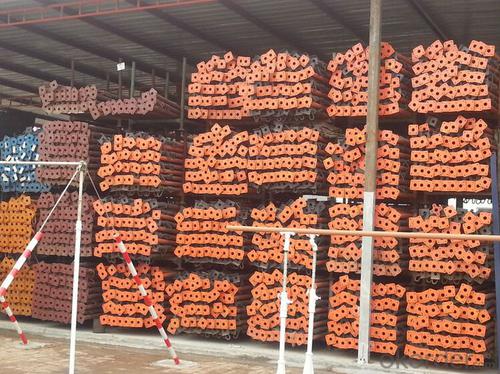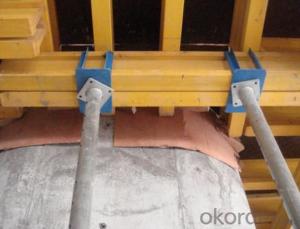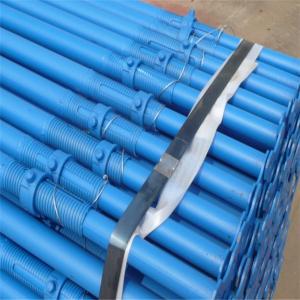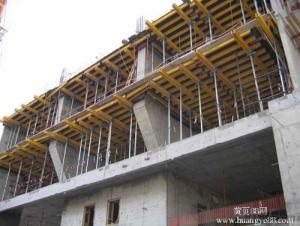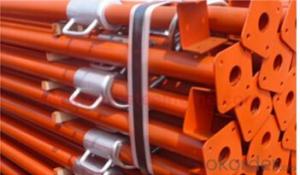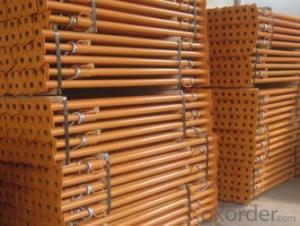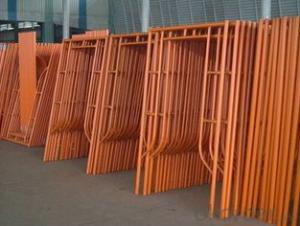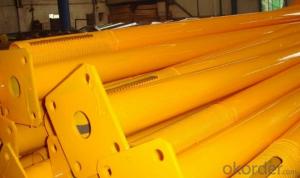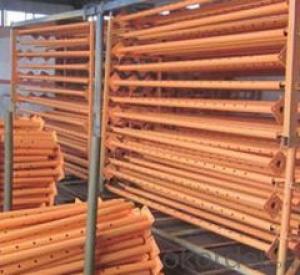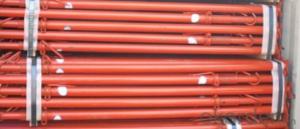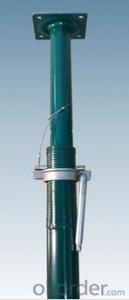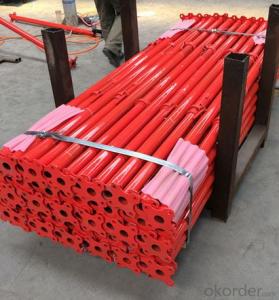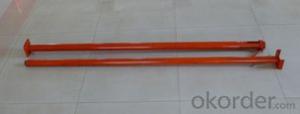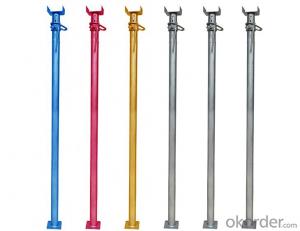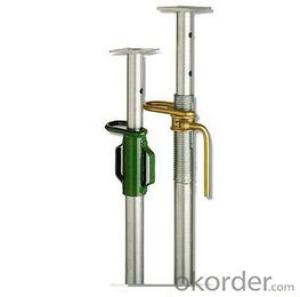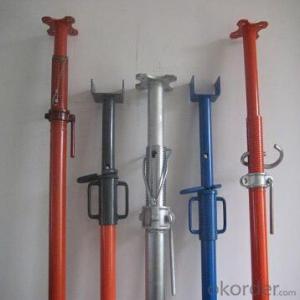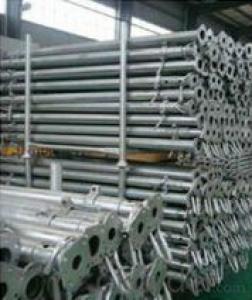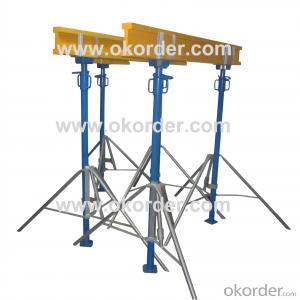High quality scaffolding steel prop
- Loading Port:
- China Main Port
- Payment Terms:
- TT OR LC
- Min Order Qty:
- -
- Supply Capability:
- -
OKorder Service Pledge
OKorder Financial Service
You Might Also Like
Quick Details
| Type: | Scaffolding Part Type: | scaffolding prop size: | |||
| scaffolding prop brand name: | scaffolding prop material: | ||||
| scaffolding prop payment terms: | scaffolding prop certification: | ||||
| scaffolding prop production capacity: | scaffolding prop surface treated: | scaffolding prop min order: |
Packaging & Delivery
| Packaging Detail: | in bundle or as your requirement |
| Delivery Detail: | 10-20 days after the order |
Specifications
scaffolding prop
1.size:1.5-5meterts
2.steel grade:Q235,Q345
3.package:in bundle
4.standard:ASTM,ANSI,BS
Scaffolding prop scaffolding material
scaffolding prop Product detail:
1.Building adjustable steel scaffolding props with U head
2.Material: Q235,Q345 Carbon Steel
3.Tube:48mm,56mm, 60mm
4.Wall thickness: 1.6mm, 1.8mm,
5.Finish: painted, powder painted, electro galvanized, hot dipped galvanized
6.scaffolding steel shoring prop
7.Heavy duty and light duty steel shoring prop
8.Bearing capacity: 10~30KN
9.Size: custom design or our regular sizes
scaffolding prop size:
- Q: What are the common sizes and lengths of steel props?
- The common sizes and lengths of steel props vary depending on their intended use and the specific requirements of the construction project. However, typical steel props range in size from 1.8 meters (6 feet) to 4.8 meters (16 feet) in length, with adjustable heights. These props are commonly used to support and stabilize structures during construction or renovation work.
- Q: How do you dismantle a steel prop after use?
- To dismantle a steel prop after use, start by removing any attached accessories or attachments. Then, loosen any adjustable parts or mechanisms and collapse the prop into its smallest form. Finally, carefully disassemble the remaining sections, using appropriate tools if necessary, until all parts are separated and ready for storage or disposal.
- Q: Can steel props be used in shopping center construction?
- Steel props are indeed applicable in the construction of shopping centers. They go by various names, such as adjustable steel props or steel shores, and are frequently employed in construction endeavors, including shopping center construction. Acting as temporary supports, they provide vertical reinforcement to structures during construction or renovation activities. Steel props exhibit versatility, strength, and durability, which renders them suitable for bearing heavy loads in shopping center construction. They can be effortlessly adjusted to varying heights and possess the capacity to withstand the weight of concrete slabs, beams, and other construction materials. Furthermore, steel props can be utilized in multiple configurations to support different sections of the shopping center, such as walls, ceilings, or floors. In summary, steel props represent a dependable and commonly embraced solution in shopping center construction projects.
- Q: What are the differences and similarities between the support of wood, steel, and steel?
- Generally, the steel support is inclined connection member, the most common is the herringbone shape and cross shape, the cross section can be steel pipe, H steel, angle steel, the role is to enhance the stability of the structure. When it comes to brace generally refers to Rachel steel purlin, is thick bar, but also to enhance the stability of the purlin purlin, not easy to lose in the external force under certain failure. Section purlin are generally H steel, C shape, Z shape, is reducing cabin panel span and fixed roof panel. Steel support is a kind of steel structure, which is used as a supporting component, which is used to support the structure of large load.
- Q: Can steel props be used for supporting temporary concert stages or platforms?
- Yes, steel props can be used for supporting temporary concert stages or platforms. Steel props, also known as adjustable props or acrow props, are commonly used in construction and temporary structures to provide support and stability. They are designed to bear heavy loads and can be easily adjusted to the desired height. When it comes to supporting temporary concert stages or platforms, steel props are an ideal choice. They can be positioned strategically underneath the stage or platform to distribute the weight evenly and ensure stability. Furthermore, their adjustable nature allows for precise leveling and customization to accommodate different stage heights or uneven ground surfaces. Steel props are made of high-quality steel and are designed to withstand significant loads, making them reliable and sturdy. They are also easy to install and dismantle, which is especially important for temporary structures like concert stages or platforms that need to be set up and taken down quickly. Overall, steel props provide the necessary support and stability required for temporary concert stages or platforms. They are a reliable and practical solution for ensuring the safety and durability of such structures.
- Q: Can steel props be used for temporary support during tank installation?
- Steel props are indeed capable of offering temporary support during tank installation. They are frequently employed in construction to provide temporary support to structures like walls, ceilings, and floors. These props can be effortlessly adjusted to the desired height and are easily installed and removed, thereby making them an optimal choice for temporary purposes. In the case of tank installation, steel props can be utilized to offer supplementary support, thereby ensuring stability and security throughout the installation procedure. Nonetheless, it is crucial to have professionals properly design and install the steel props to guarantee the safety of the installation process.
- Q: How do you determine the appropriate height of a steel prop?
- The appropriate height of a steel prop can be determined by considering factors such as the load it needs to support, the distance between the props, and the soil conditions. Additionally, consulting engineering guidelines and calculations can help determine the optimal height to ensure the safety and stability of the structure being supported.
- Q: How do you ensure the stability of a steel prop on soft ground?
- To ensure the stability of a steel prop on soft ground, several measures can be taken. Firstly, a suitable base plate or platform should be used to distribute the load and prevent sinking into the soft ground. Additionally, the base plate should be larger than the steel prop's footprint to provide a wider surface area for stability. Another approach is to use a spreader beam or a timber sleeper under the base plate to further distribute the load and reduce the risk of sinking. Lastly, regular inspections and adjustments should be made to ensure the prop remains stable throughout its use.
- Q: How do you store steel props when not in use?
- Steel props should be stored in a dry and well-ventilated area, preferably indoors, to prevent corrosion. They should be stacked on a flat surface, with a layer of wooden planks or rubber mats in between to avoid direct contact and potential damage. Additionally, it is advisable to apply a thin coat of rust-preventive oil or paint to the props before storage to further protect them from rusting.
- Q: What are the typical costs associated with using steel props?
- The typical costs associated with using steel props can vary depending on several factors. Firstly, the rental cost of steel props is a significant consideration. The length of time you need to rent the props for will impact the overall cost. Generally, the longer the rental period, the higher the cost. Additionally, the size and weight of the props will also affect the rental cost, as larger and heavier props may require more expensive equipment to transport and set up. Secondly, there may be additional costs related to delivery and installation. Some suppliers include these services in their rental fees, while others charge separately for them. If you need the props to be delivered to a specific location or require assistance with setting them up, these additional services may increase the overall cost. Maintenance and repair expenses should also be taken into account. While steel props are generally durable and strong, they may require occasional maintenance or repairs. If any damages occur during your use, you might be responsible for covering the costs of repairs or replacement. Lastly, it is worth considering the cost of insurance. Depending on the size and scale of your project, it may be necessary to have insurance coverage for the props. This can help protect against any unforeseen accidents or damages that occur while using the props. The cost of insurance will vary depending on the value of the props and the level of coverage required. Overall, it is essential to factor in all these costs associated with using steel props when budgeting for your project. It is advisable to contact multiple suppliers and compare prices to ensure you are getting the best value for your money.
Send your message to us
High quality scaffolding steel prop
- Loading Port:
- China Main Port
- Payment Terms:
- TT OR LC
- Min Order Qty:
- -
- Supply Capability:
- -
OKorder Service Pledge
OKorder Financial Service
Similar products
Hot products
Hot Searches
Related keywords
